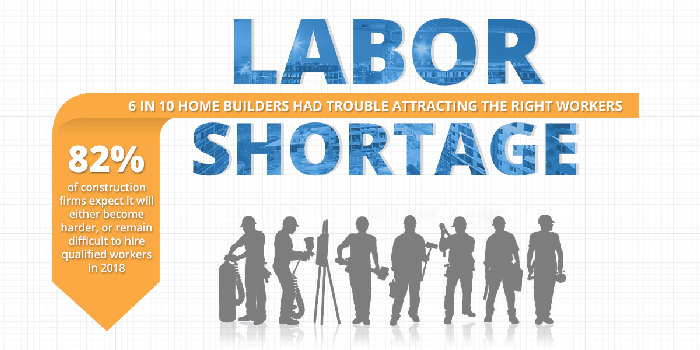According to a recent survey by NAHB the top challenges in 2018 for homebuilders are labor and materials costs. While 2017 was a hot market for homebuilders, and the trend looks to continue into 2018, the industry will still face these and other significant obstacles that affect the bottom line.
While Mother Nature and tariffs on lumber had a hand in increasing materials costs, the labor shortage has touched a majority of homebuilders with six in 10 having had trouble attracting the right workers, according to a U.S. Chamber of Commerce report. And, it’s not just the shortage of labor that’s at issue, but also the cost of labor, as the strong housing market and worker shortage have created a vicious cycle of increasing labor costs.
But this ongoing trend can be an opportunity to embrace new hiring practices and bring new energy to the worker pool. To help you think outside the box and be resourceful in your hiring, we have the following tips to help you recruit not only the workers you need, but the workers you want.
Understand who you are competing against for labor
If there is a shortage of workers, the first question should be “where did they go?’ At first glance, it may not make sense that you have lost a potential employee to a restaurant or service job. But digging a little deeper, you’ll find that these positions often offer benefits and stability, important key factors when choosing a job.
To compete with this, you will need to evaluate your compensation package. Even if it isn’t possible to offer benefits, consider offering other compensation incentives that put you in contention with job searchers. This is especially important to attract highly desired skilled labor.
Attract with technology
Much has been said about the aging workforce in construction and the difficulty in attracting younger workers. With tech being used more and more in building, it can be a carrot to attracting a younger workforce. Today, tech touches every aspect of the industry; and that can be your hook to younger workers. Show them that there are “cool” aspects to the job; drones, cloud based project management, wearable tech, safety gear, etc. And, don’t forget to show them the future of how autonomous vehicles, robotics and AR will be used in building.
Set up a referral program
Offer your employees cash or another reward for recommending friends and acquaintances for the job. Be clear of what positions you are hiring and the required skills, so there is no confusion. Remember to make it easy to participate, engage your staff by regularly communicating open positions and measure results. Of course only give the reward after the person is hired and makes it through their probationary period.
Learn how to recruit Millennials
Millennials like to know that they have a career path ahead of them, as well as a steady, fulltime job. That’s why training programs are an important key to attracting millennials. By investing in and providing training, you are showing this group that you are willing to improve their skills and make them a valuable part of the workforce. Establish mentoring and skills programs with rewards to motivate them as they move up the training ladder. Make sure these programs are communicated early during the interview process.
Be open to a range of backgrounds
During a labor shortage it’s important to look beyond the usual and increase your options by hiring from diverse backgrounds. Don’t turn someone away just because they don’t have specific experience in building. Look at sources not usually on the radar for your recruiting, such as people looking to make a career change, as well as people that have transferable skills that translate to your business. Most importantly, look for people who are a good fit for your company culture.
Plan for the future
Now is the time to invest and hire for the long term. It is also the time to create a succession plan for essential roles in your company. Identify potential gaps in knowledge and invest in training and leadership development to ensure your company has the depth to maintain project performance as your company grows.





